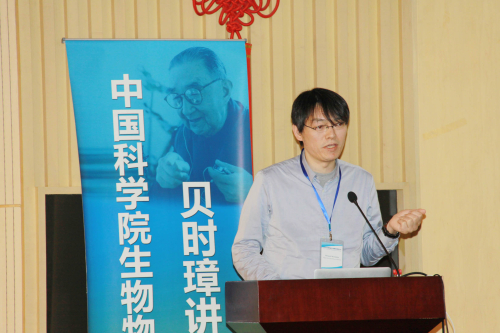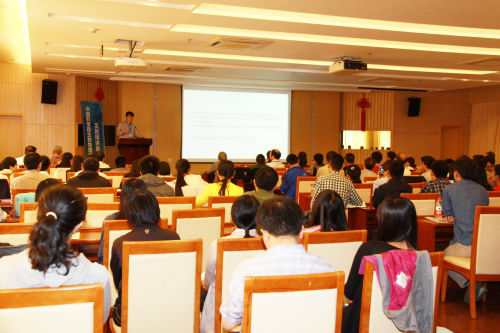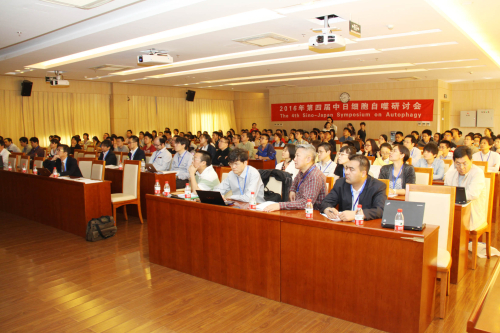Prof. Masaaki Komatsu from Niigata University Visited IBP and Delivered the Shizhang Bei Lecture
<>On April 23, 2016, Prof. Masaaki Komatsu visited Institute of Biophysics, CAS and gave a lecture entitled Autophagy-adaptors regulate cellular metabolism through multiple transcription-factor pathways. This lecture, which is a part of the special lecture series of BEI Shizhang Lecture of IBP, was hosted by Prof. Hong Zhang.
Dr Komatsu is one of the earliest researchers who studied the physiological function of autophagy gene in vivo. Their group constructed Atg7 conditional knockout mice, and demonstrated that autophagy process plays an important role in maintaining the homeostasis of the central nervous system. Meanwhile, they also revealed that autophagy is critical for normal function of liver. Specific liver knockout of Atg7 could cause severe hepatocyte swelling and damage, which lead to cancer at later stage. These findings provide us a better understanding of how autophagy functions in the physiological and pathological processes.
In the following studies, Dr Komatsu’s group discovered that Nrf2-Keap1 pathway plays an essential role in the process of liver damage caused by autophagy blockage. The Nrf2-Keap1 system is involved in the oxidative-stress response, metabolic pathways, and innate immunity. Under normal conditions, the transcription factor Nrf2 is constitutively degraded through the ubiquitin-proteasome pathway through binding to its partner Keap1, which is an adaptor of the ubiquitin ligase complex. When autophagy is defective, autophagy adaptor protein p62 accumulates, and competitively binds to Keap1 and results in the release of Nrf2. Activated Nrf2 becomes stabilized and translocates to the nucleus to induce the transcription and expression of various cytoprotective enzymes. The abnormal accumulation of these enzymes causes massive swelling and damage to hepatocytes. To confirm the involvement of Nrf2-keap1 pathway, Dr Komatsu’s group constructed Nrf2 knockout mice, and found that Nrf2-deficiency dramatically suppresses the liver damage caused by autophagy gene knockout. They also found that S351 phosphorylation of p62 could markedly increase its binding with Keap1, while accumulation of phosphorylated p62 contributes to the growth of human hepatocellular carcinomas. Their study provides a new potential therapeutic target against human hepatocellular carcinomas by discovering inhibitors of the interaction between phosphorylated p62 and Keap1.
Prof. Masaaki Komatsu gave the lecture with vivid words, rigorous logic and great passion, which can be a lively lesson for the audience. Investigators and young scientists attending the lecture included Dr. Quan Chen, Wei Liu, Shengcai Lin, Chonglin Yang and Li Wei. After the lecture, Prof. Masaaki Komatsu and the audience shared their views on the issues of common interest.
Dr Komatsu is one of the earliest researchers who studied the physiological function of autophagy gene in vivo. Their group constructed Atg7 conditional knockout mice, and demonstrated that autophagy process plays an important role in maintaining the homeostasis of the central nervous system. Meanwhile, they also revealed that autophagy is critical for normal function of liver. Specific liver knockout of Atg7 could cause severe hepatocyte swelling and damage, which lead to cancer at later stage. These findings provide us a better understanding of how autophagy functions in the physiological and pathological processes.
In the following studies, Dr Komatsu’s group discovered that Nrf2-Keap1 pathway plays an essential role in the process of liver damage caused by autophagy blockage. The Nrf2-Keap1 system is involved in the oxidative-stress response, metabolic pathways, and innate immunity. Under normal conditions, the transcription factor Nrf2 is constitutively degraded through the ubiquitin-proteasome pathway through binding to its partner Keap1, which is an adaptor of the ubiquitin ligase complex. When autophagy is defective, autophagy adaptor protein p62 accumulates, and competitively binds to Keap1 and results in the release of Nrf2. Activated Nrf2 becomes stabilized and translocates to the nucleus to induce the transcription and expression of various cytoprotective enzymes. The abnormal accumulation of these enzymes causes massive swelling and damage to hepatocytes. To confirm the involvement of Nrf2-keap1 pathway, Dr Komatsu’s group constructed Nrf2 knockout mice, and found that Nrf2-deficiency dramatically suppresses the liver damage caused by autophagy gene knockout. They also found that S351 phosphorylation of p62 could markedly increase its binding with Keap1, while accumulation of phosphorylated p62 contributes to the growth of human hepatocellular carcinomas. Their study provides a new potential therapeutic target against human hepatocellular carcinomas by discovering inhibitors of the interaction between phosphorylated p62 and Keap1.
Prof. Masaaki Komatsu gave the lecture with vivid words, rigorous logic and great passion, which can be a lively lesson for the audience. Investigators and young scientists attending the lecture included Dr. Quan Chen, Wei Liu, Shengcai Lin, Chonglin Yang and Li Wei. After the lecture, Prof. Masaaki Komatsu and the audience shared their views on the issues of common interest.




